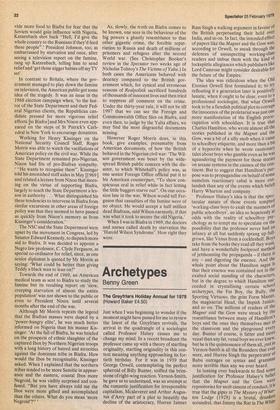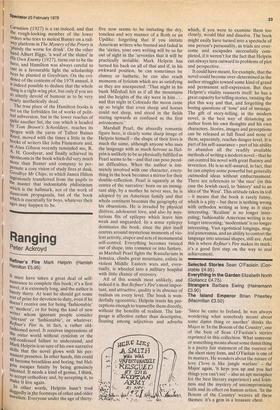Archetypes
Benny Green
The Greyfrlars Holiday Annual for 1978 (Howard Baker £4.50) Just when I was beginning to wonder if the moment might have passed for me to review the latest of the Greyfriars revivals, the arrival in the quadrangle of a sociologist called Professor Halsey causes me to change my mind. In a recent broadcast the professor came up with a theory of startling originality, startling originality in this context meaning anything approaching its fortieth birthday. For it was in 1939 that George Orwell, contemplating the perfect spheroid of Billy Bunter, sniffed the brimstone of right-wing reaction. Vernon-Smith, he gave us to understand, was an attempt at the romantic justification for irresponsible capitalism, ME, uleverer and Arthur Augustus d'Arcy part of a plot to beautify the decline of the aristocracy, Hurree Jamset
Ram Singh a walking argument in favour of the British perpetuating their hold over India, and so on. In fact, the intended effect of papers like the Magnet and the Gem was, according to Orwell, to sneak through the defences of unsuspecting working-class readers and imbue them with the kind of lockspittle allegiances which publishers like Lord Camrose might consider desirable for the future of the Empire. The idea was ridiculous when the Old Etonian Orwell first formulated it; to try refloating it a generation later is positivelY lunatic, when it ought to be clear, even to a professional sociologist, that what Orwell took to be a fiendish political plot to corruPr the innocence of the proletariat was just one more manifestation of the English preoccupation with schooldays. It is true that Charles Hamilton, who wrote almost all the stories published in the Magnet and the Gem, was a bit of a silly snob when it came to schoolboy etiquette, and more than a bit of a hypocrite when he wrote cautionarY tales about boys who gamble even as he was squandering the payment for those stories on arcane systems in the casinos of the continent. But to suggest that Hamilton's purpose was to propagandise on behalf of some nameless reactionary cabal is more outlandish than any of the events which befell Harry Wharton and company.
Professor Halsey's idea is that the sPec", tacular nature of those events tempto, 'working-class boys to exalt the manners oi public schoolboys', an idea so hopelessly at odds with the reality of schoolboy psychology as to tempt me to speculate on the possibility that the professor never had an infancy at all but suddenly sprang up full' grown, like Venus from a cockleshell. Boys take from the books they read all they want, and have a wonderfully foolproof method of jettisonning the propaganda — if there Is any — and digesting the essence. And the whole point about the Hamilton sagas Is that their essence was contained not in the exalted social standing of the characters, but in the degree to which Hamilton suc" ceeded in crystallising certain school archetypes, the Fat Boy, the Bully, the Sporting Virtuoso, the grim Form Master, the magisterial Head, the Impish Junior, and so on. The millions of readers of the
Magnet and the Gem were struck by Or resemblance between many of Hamilton s boys and the ones they themselves met le the classroom and the playground everY day. Bunter of course, is fatter and more venal than any fat, venal boys we ever kneW'
but he is the quintessence of them all, just as Vernon-Smith is all the Bounders that ever were, and Hurree Singh the perpetrator ol Babu outrages on syntax and gramtpar more terrible than any we ever heard. In leaning over backwards to find son.le, justification for Professor Halsey's belle' that the Magnet and the Gem were repositories for snob canons of conduct, it Is true that the gipsy in The Mystery of Whar
ton Lodge (1928) is a brutal, drunk' scoundrel, that Jimmy the Rat in The White
Carnation (1927) is a rat indeed, and that the rough-looking member of the lower orders who tries to molest Bunter on a rail!ay platform in The Mystery of the Priory is Plainly the worse for drink'. On the other hand Albert Biggs, 'a waif of the slums' in His Own Enemy (1927), turns out to be the hero, and Hamilton was always careful to cast in a favourable light the scholarship boys he planted at Greyfriars. On the evidence of the contents of the 1978 annual, it Is indeed possible to deduce that the whole thing is a right-wing plot, but only if you are SO utterly devoid of humour as to be very nearly aesthetically dead. The true place of the Hamilton books is not on the forbidden list of works of political subversion, but in the lower reaches of quite another list, the one which is headed by Tom Brown's Schooldays, reaches its aPogee with the yarns of Talbot Baines heed, moved with the times a little in the books of writers like John Finnemore and, as Alan Gibson recently reminded me, R. A. H. Goodyear, and finally achieved its apotheosis in the book which did very much More than Bunter and company to perPetuate a cosy vision of study fires at dusk, G. oodbye Mr Chips, in which James Hilton Ingeniously transferred from the pupils to Inc master that indomitable philistinism Which is the hallmark, not of the work of classroom propaganda, but of the book Which is essentially for boys, whatever their ages may happen to be.
1111111111111■'



































 Previous page
Previous page